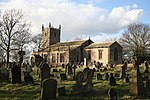Bottesford, Lincolnshire
Borough of North LincolnshireCivil parishes in LincolnshireScunthorpeTowns in LincolnshireUse British English from October 2014

Bottesford is a town in North Lincolnshire, Lincolnshire, England.Historically a village, Bottesford forms a contiguous urban area of Scunthorpe. In the 2001 Census, Bottesford's population was recorded as 11,171, falling to 11,038 at the 2011 census. The town is directly south of Scunthorpe, west of Brigg and north of Gainsborough and Kirton in Lindsey.
Excerpt from the Wikipedia article Bottesford, Lincolnshire (License: CC BY-SA 3.0, Authors, Images).Bottesford, Lincolnshire
Headingley Avenue,
Geographical coordinates (GPS) Address Nearby Places Show on map
Geographical coordinates (GPS)
| Latitude | Longitude |
|---|---|
| N 53.55206 ° | E -0.67143 ° |
Address
Headingley Avenue
DN17 2GG , Yaddlethorpe
England, United Kingdom
Open on Google Maps





